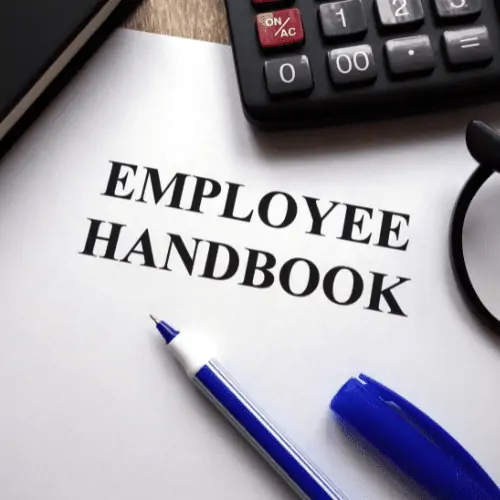2023 Employee Handbooks: 5 Key Updates
October 5th, 2022

Updating your employee handbook is one of the most critical annual initiatives for a human resource department. The employee manual ensures compliance with industry standards and federal and state laws. It reduces risk and exposure for the company. Lastly, an employee handbook carries the organization’s mission statement and helps develop a strong company culture. Organizations should never just use an employee handbook template, though. Every year brings new compliance requirements and work environment trends, such as remote working. MP’s HR experts share five essential updates every employer should consider when updating their employee handbook for 2023.
5 Key Employee Handbook Updates for 2023
1. DEI and The CROWN Act.
Diversity, equity, and inclusion (DEI) has been a hot-button topic for employers for a long time. However, in 2023, many organizations may need to create or update specific policies (including grooming and dress code policies) and language in their employee handbook for a few reasons. Firstly, there are 18 states with their own version of The CROWN Act. This legislation protects employees (often black women) with natural hairstyles from discrimination. There may be a federal CROWN Act in the future, as well. Additionally, more states are adding natural hairstyles to the list of protected classes. Outside of a legal perspective, DEI is becoming more important to all workers. A report by the Pew Research Center finds that Generation Z is the most ethnically and racially diverse generation yet. This means the talent employers are trying to attract and retain are racially and ethnically diverse, or they have deep connections with people who are. Employers will pay the price in talent loss if they don’t update their employee handbook to support DEI efforts, reduce opportunities for discrimination, and condemn racism, sexism, homophobia, and general bigotry.
2. Hybrid or remote work policies.
Organizations that don’t already have hybrid or remote work policies should develop them for their 2023 employee handbooks. Many organizations assume there’s no need for policies if employees have already been successfully working on a remote or hybrid basis. However, these policies are vital for protecting the company from unnecessary risk and exposure, improving employee performance and experience, and ensuring the organization gets all its equipment back when employees move on. A telework policy should address these items:
- How employees deliver work
- How meetings are conducted, including technologies used and dress codes
- Expected working hours and scheduling
- Expectations for employee availability and response times
- Rules for cyber safety
- Technologies and equipment employees will use
- The return of equipment when employees move on
- Inclement weather procedures, especially whether employees will still work if the headquarters is closed
3. Policies to promote employee wellness and mental health.
To retain staff in 2023, employers will need to keep up with the recent trend in supporting employee wellness and mental health. The pandemic accelerated this trend. In 2023, supporting employee health and wellness doesn’t just mean offering solid health insurance. Employers should deeply review employee benefits and a general prioritization of employee wellness. Do they offer enough vacation time for employees to avoid burnout? Do their health insurance plans make mental health care more accessible? Many employers are offering mental health days and Employer Assistance Programs (EAPs) to improve access to mental health care services. Employers may also want to adopt language urging employees to stay home or work from home when sick. FMLA policies can be expanded to include language about mental health conditions, which often also qualify for leave. Lastly, it may be a good idea for employers to create a specific “Wellness Policy” in their 2023 employee handbook. This policy could encapsulate all the initiatives and benefits offered to support employees’ physical and mental health. It’s important to note that all of these changes in the handbook are useless, if not detrimental, if employers don’t also practice them in the workplace. For example, employers should not add a mental health day to the benefits listed in their handbook if they aren’t ready for employees to take it.
4. Parental leave policies and benefits for working parents.
Employee handbooks should be updated to meet new and changing parental leave programs, as well as the expectations of working parents generally. Parental leave policies have been multiplying all over the US. Currently, ten states in the US have paid parental leave programs, with more states working on their own. Employers in these ten states and with employees who work remotely from these states must have paid family leave policies that are updated and in compliance. Beyond the legal requirements, employers should also seriously consider offering more flexibility for working parents as part of their employer brand. Post-pandemic, employees can expect a substantial increase in flexibility at work. Parents in particular have benefitted from this flexibility and often consider it a necessity, not a perk. Especially in the current, tight labor market, employers are more likely to lose talent (or have trouble attracting it) when they don’t offer the flexibility that working parents demand.
5. Wage and hour changes.
Organizations should work with HR experts like MP to stay updated on all relevant wage and hour employment law changes. This could include minimum wage changes in their state (or states employees are working in), as well as pay equity and pay transparency laws. There are now pay transparency laws in California, Colorado, Connecticut, Maryland, Nevada, Rhode Island, and Washington. Per an Inc. article, employers across every industry are embracing it (or being forced to) even in states where pay transparency isn’t required. Employers may need to note their compliance with these laws in their employee handbook in policies for hiring or posting jobs. Changes in state minimum wage laws may impact the language in an employer’s exempt and nonexempt employee policies. Lastly, employers should ensure overall compliance with any wage and hour policies in their 2023 employee handbook because the Department of Labor (DOL) has been significantly more aggressive about audits. Going into 2023, employers should prioritize preventing these costly DOL audits, which may also open them up to other audits, legal action, and other devastating consequences
,
Recent Posts
- Seasonal Workforce Simplified: A Blueprint for Employers
- The Payroll Customer Service Struggle: What’s Really Going On?
- Navigating Workforce Management: Challenges, Strategies, and Solutions
- The Importance of Training in Today’s Workplace: A Holistic Approach
- Achieving and Maintaining Compliance in 2025: Key Insights for Employers
Categories
- ACA (10)
- AI (5)
- BizFeed (6)
- Business Strategy (119)
- COBRA (5)
- Compliance (191)
- COVID-19 (92)
- Diversity (12)
- eBooks (19)
- Employee Engagement (33)
- Employee Handbooks (24)
- ERTC (29)
- FFCRA (7)
- HR (305)
- MP Insider (13)
- Payroll (112)
- PFML (9)
- PPP (24)
- PTO (5)
- Recruiting (53)
- Remote Work (39)
- Return to Work (32)
- Unemployment (1)
- Wellness (22)
Archives
- March 2025
- February 2025
- January 2025
- December 2024
- November 2024
- October 2024
- September 2024
- August 2024
- July 2024
- June 2024
- May 2024
- April 2024
- March 2024
- February 2024
- January 2024
- December 2023
- November 2023
- October 2023
- July 2023
- June 2023
- May 2023
- April 2023
- March 2023
- January 2023
- December 2022
- October 2022
- September 2022
- August 2022
- July 2022
- June 2022
- May 2022
- April 2022
- March 2022
- February 2022
- January 2022
- December 2021
- November 2021
- October 2021
- September 2021
- August 2021
- July 2021
- June 2021
- May 2021
- April 2021
- March 2021
- February 2021
- January 2021
- December 2020
- November 2020
- October 2020
- September 2020
- August 2020
- July 2020
- June 2020
- May 2020
- April 2020
- March 2020



